Famous Expressionist Artists – Top Expressionists of the Movement
Expression is something that is not borne out of logic, but something rawer and more authentic, revealing feelings and opinions through verbal means or action. During the early 20th century, the need for artists to express themselves from a personal perspective took shape in the form of the Expressionist art movement. Its evocative style characterized by its distortion of form, visible brushstrokes, hard lines, and striking color usage spread through Europe, leading to artists producing many famous works of art.
Contents
- 1 What Is Expressionism?
- 2 Famous Expressionist Artists and Their Important Artworks
- 2.1 Vincent van Gogh (1853 – 1890)
- 2.2 Edvard Munch (1863 – 1944)
- 2.3 Wassily Kandinsky (1866 – 1944)
- 2.4 Emil Nolde (1867 – 1956)
- 2.5 Paul Klee (1879 – 1940)
- 2.6 Franz Marc (1880 – 1916)
- 2.7 Ernst Ludwig Kirchner (1880 – 1938)
- 2.8 Erich Heckel (1883 – 1970)
- 2.9 Egon Schiele (1890 – 1918)
- 2.10 Chaïm Soutine (1893 – 1943)
- 3 Frequently Asked Questions
What Is Expressionism?
Expressionism is an art movement that originated in Northern Europe in about 1905 and lasted until about 1920. Expressionists strove to depict their emotional or subjective experience rather than their physical reality. Their art is characterized by an abstract style of painting, in which the artists used broad, expressive brushstrokes and bold pops of color. Expressionism was a broad modernist movement that spread into various creative fields across the world, such as visual art, music, literature, architecture, as well as theatre.
In France, Expressionism arose as a reaction to the Impressionist art movement, and it was here that artists painted the world around them not as it looked, but from a personal perspective.
This style moved away from realistic depictions of everyday life to a raw, emotional representation of how they perceived it. Expressionism in Germany was inspired by the Middle Ages, mysticism, and the influential philosopher, Friedrich Nietzsche, and is especially associated with the groups, Die Brücke, and Der Blaue Reiter.
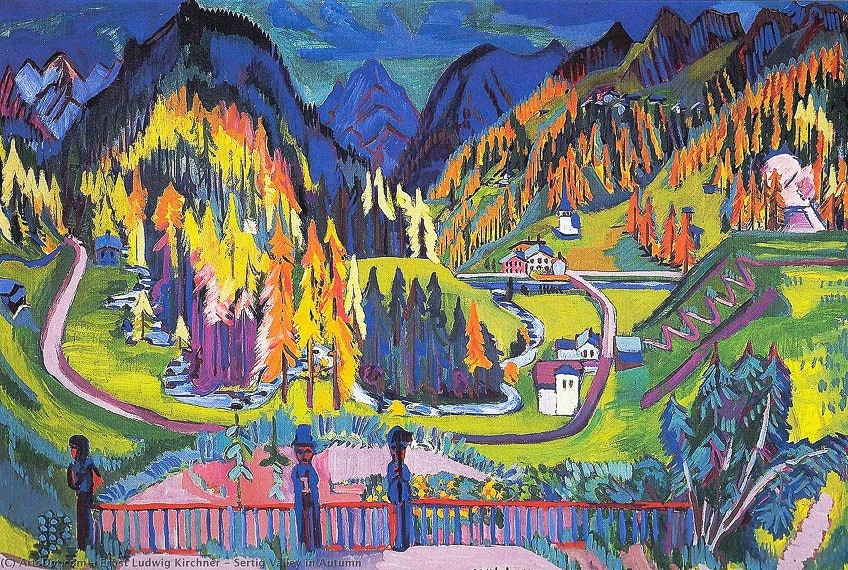
Die Brücke was formed in 1905 by a group of expressionist painters who were against the bourgeois social structure of the country, while Der Blaue Reiter came together in 1911 as a reaction to the increasingly modernized world and sought to go beyond the ordinary by pursuing a more spiritual approach to art.
In Austria, Expressionism came about during a time of moral repression and sexual hypocrisy, and themes such as violence, death, sex, and desire became popular visual topics at the time.
Therefore, Expressionism was not simply defined by a group of aesthetic principles, but it was a movement borne from the need to express and battle social structures and norms. Expressionism artists were reacting to the world around them, their artworks embodying the emotional stress and experiences they felt.
Famous Expressionist Artists and Their Important Artworks
There are many influential artists from the expressionism movement, each contributing their flair to the expressionist style. However, because we cannot discuss them all, we have listed 10 artists below that pioneered and contributed to the expressionist movement as well as a few of their most famous works.
These artists are all male as it seems that there were unfortunately no female artists that drove the expressionist movement.
The art world was male dominated during this period and many female artists were either excluded or underrated. Although there were female artists who painted expressively, they were not directly involved in the expressionist movement.
Vincent van Gogh (1853 – 1890)
| Artist | Vincent van Gogh |
| When the Artist Lived | 1853 – 1890 |
| Nationality of the Artist | Dutch |
| Where the Artist Lived | Netherlands |
| Associated Art Movements | Post-Impressionism, Pointillism, Neo-Impressionism |
Vincent van Gogh, or Vincent Willem van Gogh, was a Dutch painter who became one of the most famous and influential artists in Western art history after his death. He was a very influential post-Impressionist artist who was also an important pioneer of expressionistic art.
His landscapes and compositions of the night sky painted with colorful expressive brushstrokes and otherworldly style influenced expressionists that came after him.
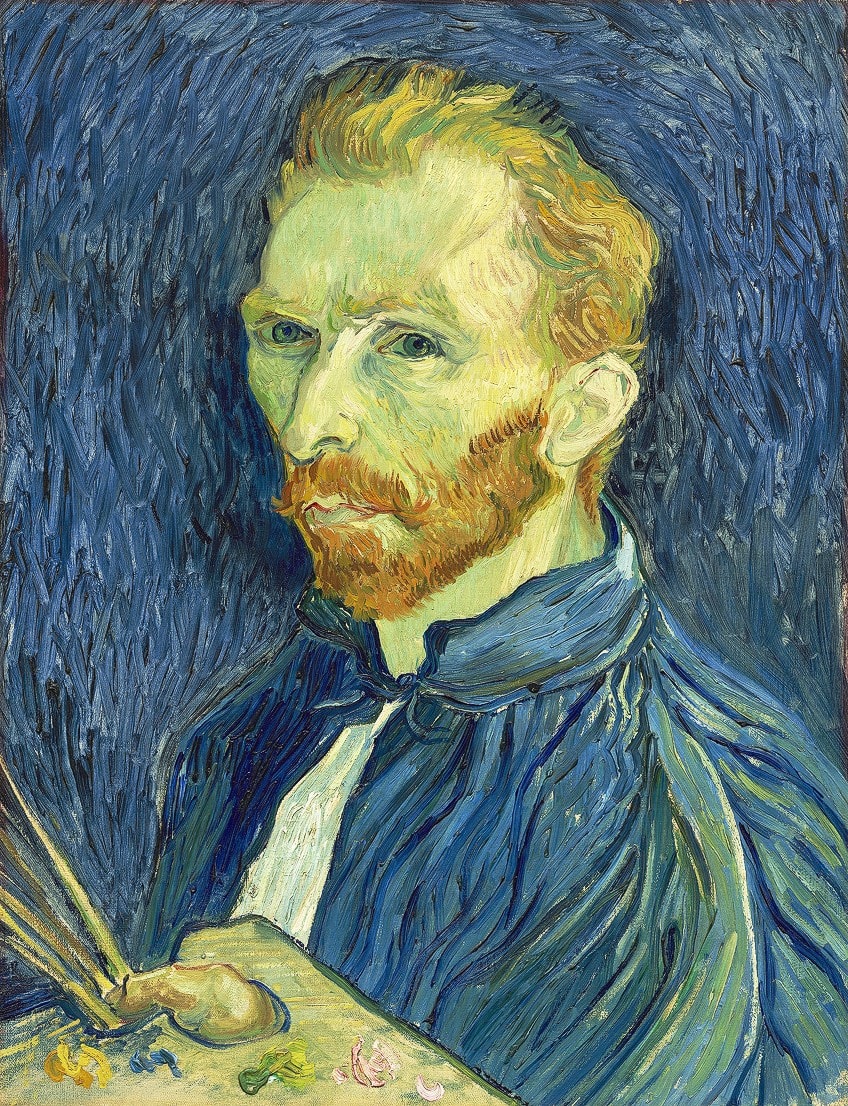
Van Gogh has become known by the world as the classic tortured artist, mostly because of his published letters. He struggled with mental illness and in despair, eventually committed suicide. The subjects that van Gogh painted were landscapes, still lifes, and figures, all of which relate to the countryside and the hard life that peasant folk experienced.
The Starry Night (1889) by Vincent van Gogh
| Date Completed | 1889 |
| Dimensions (cm) | 74 x 92 |
| Medium | Oil on canvas |
| Where It Is Currently Housed | The Museum of Modern Art |
The Starry Night (1889) is an oil painting depicting the view from the bedroom window at Saint-Rémy-de-Provence, his asylum. The sky is shown before sunrise, the village in the composition imaginary. The sky is full of magical energy.
The exploding swirls of stars and movement depicted throughout contrast with the quiet and serene village.
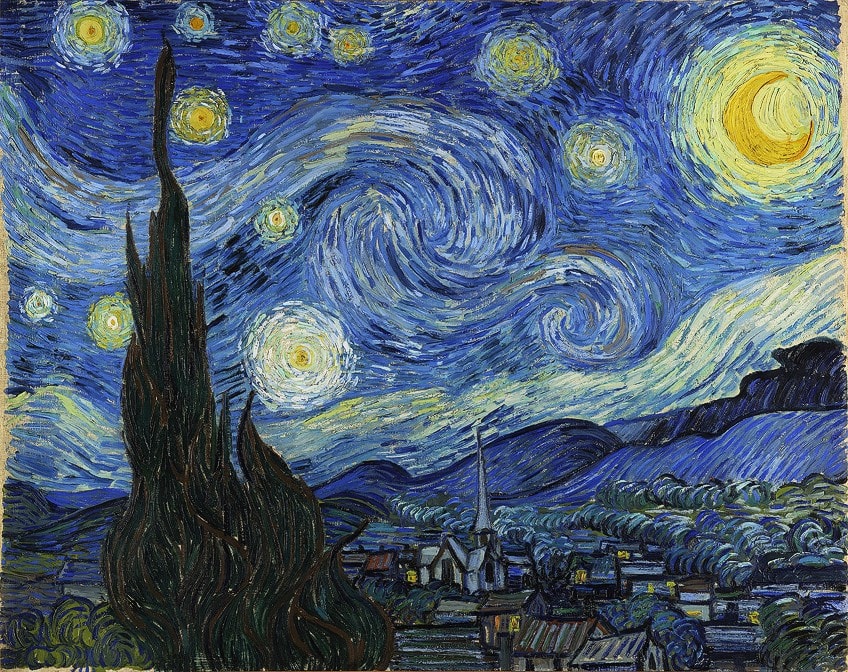
The tree joining the earth and sky is a cypress tree, traditionally associated with mourning. The entire work is charged with expressionistic energy, capturing a dreamlike state. In this world, the night is still very much alive and active, while people are in slumber.
Some of van Gogh’s other famous works include:
- Sunflowers (1888)
- The Red Vineyard (1888)
- Self-portrait (1889)
- The Bedroom (1889)
- Wheatfield with Crows (1890)
Edvard Munch (1863 – 1944)
| Artist | Edvard Munch |
| When the Artist Lived | 1863 – 1944 |
| Nationality of the Artist | Norwegian |
| Where the Artist Lived | Norway |
| Associated Art Movements | Modernism, Impressionism, Post-Impressionism, Symbolism |
Edvard Munch was a Norwegian painter that greatly influenced German Expressionism with his graphic use of psychological themes. He had a great influence during the Modernist movement and played a role in the Symbolist movement as well.
Munch had a difficult upbringing; illness plagued his family, and he lost his father and brother at a young age.

A sister of his developed mental illness and he dreaded inheriting the same fate. He was inspired by artists such as Paul Gauguin, Vincent van Gogh, and Claude Monet and his career spanned over 60 years, during which he created numerous evocative masterpieces.
The Scream (1893) by Edvard Munch
| Date Completed | 1893 |
| Dimensions (cm) | 91 x 73.5 |
| Medium | Oil on canvas |
| Where It Is Currently Housed | National Gallery and Munch Museum |
Edvard Munch’s most well-known work is The Scream (1893), a mixed media painting created with oil, tempera, and pastel on cardboard. The haunting image of the figure holding their face in anguish has become an iconic image in the world of art. The work is known for representing the sense of anxiety and fear experienced by people during the modernist period.
It is based on a moment of alienation and melancholy in Munch’s life when two of his friends left him behind.

These two friends can be seen in the background of Munch’s composition. An autobiographical work, The Scream reflects the psychological struggles that Edvard Munch battled for most of his life. He painted two different versions of The Scream.
One painting is located at the Oslo National Gallery and the other is at the Munch Museum in Oslo.
Some of Munch’s other famous works include:
- Vampire (1893)
- Anxiety (1894)
- Puberty (1895)
- Separation (1896)
- The Kiss (1897)
Wassily Kandinsky (1866 – 1944)
| Artist | Wassily Kandinsky |
| When the Artist Lived | 1866 – 1944 |
| Nationality of the Artist | Russian |
| Where the Artist Lived | Russia, Ukraine, Germany, France |
| Associated Art Movements | Post-Impressionism, Art Nouveau, Modernism, Abstract Art, Suprematism |
Wassily Kandinsky was a Russian painter and one of the famous abstract expressionist artists. He was an art theorist and a founder of the group, Der Blaue Reiter. Kandinsky is recognized as one of the forerunners of abstraction in art in the West. His style changed and evolved various times throughout his career, from painting realistic subjects to more abstract and geometric forms.
He sought to convey a sense of spirituality with his art that was universal, using imagery that expressed his inner experience and was only loosely connected to reality.
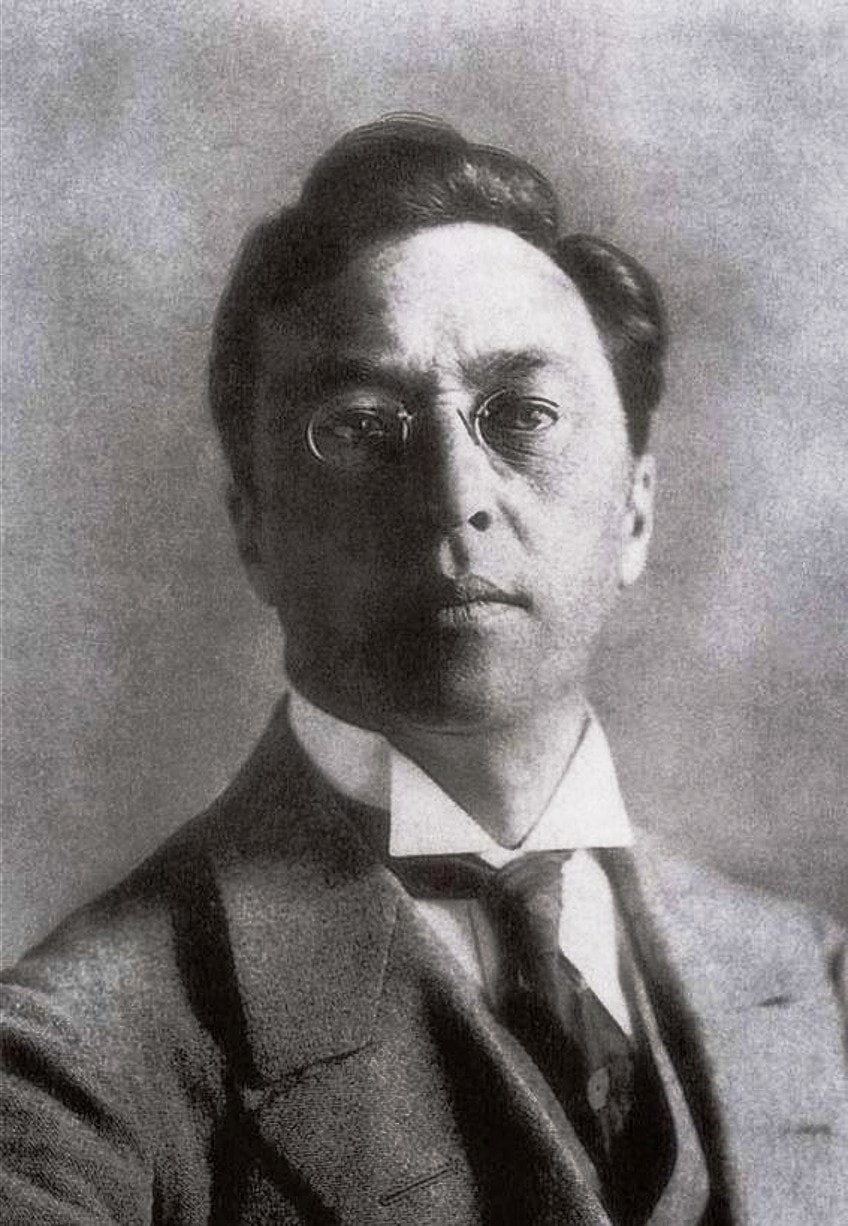
Der Blaue Reiter (The Blue Rider) (1903) by Wassily Kandinsky
| Date Completed | 1903 |
| Dimensions (cm) | 55 x 60 |
| Medium | Oil on card |
| Where It Is Currently Housed | Private Collection |
Wassily Kandinsky’s work, Der Blaue Reiter (The Blue Rider) (1903), titled the same as the artistic group he later founded, is a simple oil painting of a rider and his horse racing alone across an open field with trees in the background.
This painting shows a link in style to the impressionists, but a shift to the expressionistic style can be seen in his use of thick paint, bold colors, and uneven brushstrokes.
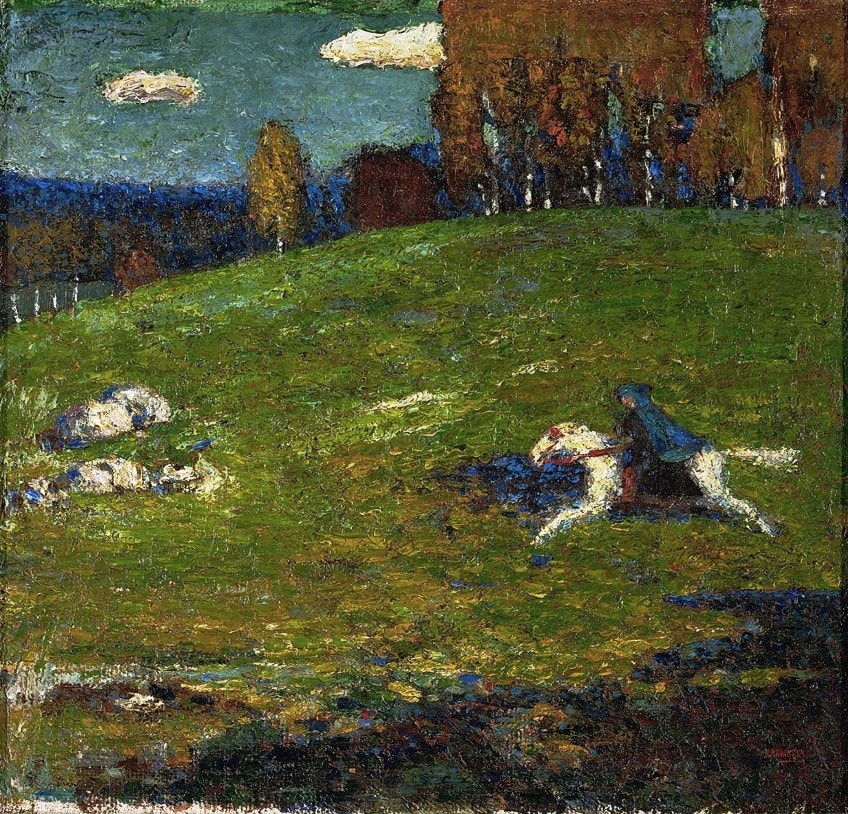
The picture of the rider is almost hazy with the colors blending, hinting at Kandinsky’s interest in abstraction. The artwork holds lots of movement, which imbues it with a great sense of haste as the rider rushes through the composition.
Some of Kandinsky’s other famous works include:
- Couple Riding (1906)
- Der Blaue Berg (The Blue Mountain) (1908 – 1909)
- Railroad at Murnau (1909)
- Composition IV (1911)
- Moscow I (Red Square) (1916)
Emil Nolde (1867 – 1956)
| Artist | Emil Nolde |
| When the Artist Lived | 1867 – 1956 |
| Nationality of the Artist | German-Danish |
| Where the Artist Lived | Denmark, Germany |
| Associated Art Movements | Modern Art |
Emil Nolde was a German-Danish expressionist painter and was a member of Die Brücke. He is known as an extraordinary colorist during the modernist period, creating dynamic works with large brushstrokes and contrasting colors.
Nolde grew up in the Protestant faith and gained inspiration for his art from the Bible, restoring the use of Christian imagery in a vibrant, abstract style.
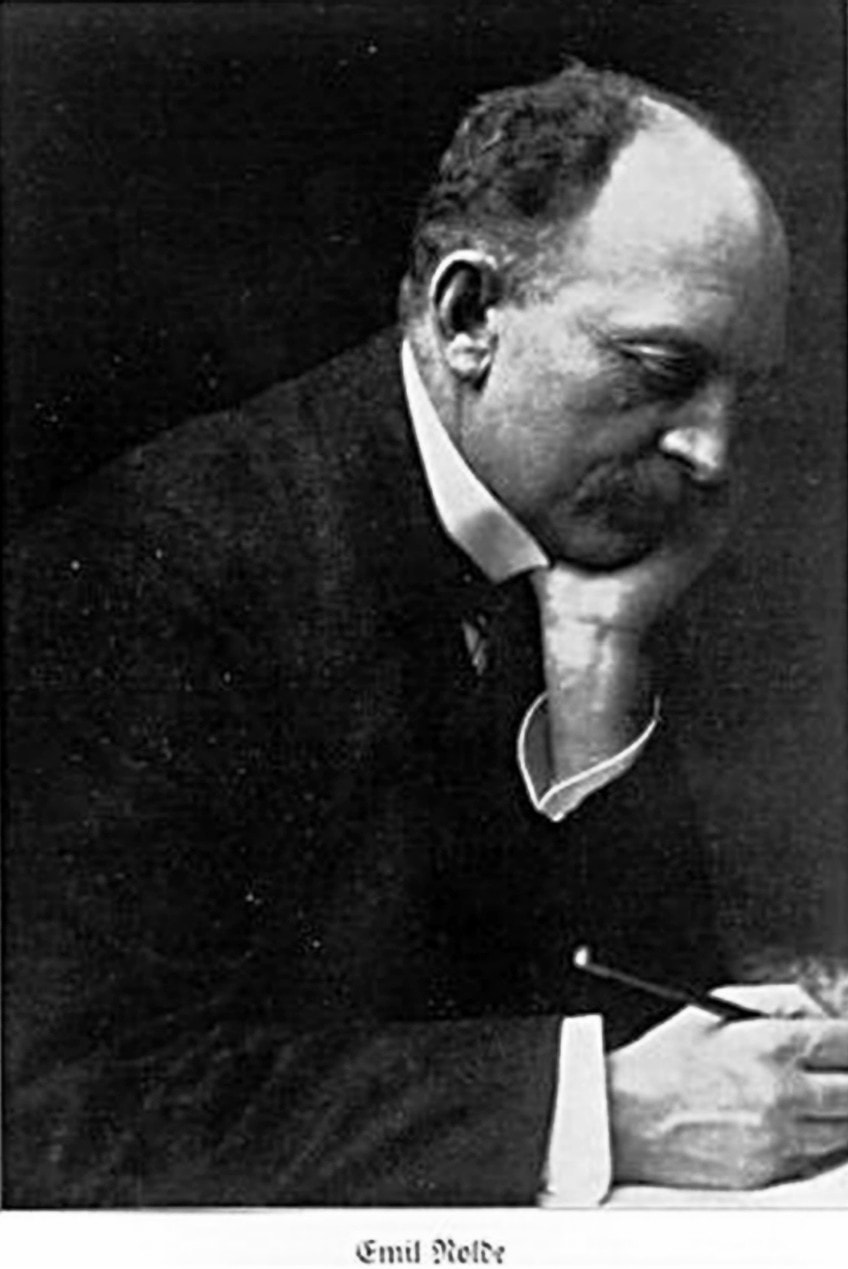
Dance Around the Golden Calf (1910) by Emil Nolde
| Date Completed | 1910 |
| Dimensions (cm) | 88 x 105.5 |
| Medium | Oil on canvas |
| Where It Is Currently Housed | Neue Pinakothek |
Dance Around the Golden Calf (1910) reflects Emil Nolde’s religious influence as it portrays an important section from the book of Exodus in the Bible. The bold use of color and subject matter in this oil painting suggests a Fauvist influence.
It depicts near-naked female figures dancing around an idol, the golden calf.
According to the story, the Israelites made the idol to appease the people while Moses was away at Mount Sinai. The expressive movement and bright colors in Dance Around the Golden Calf are used to portray their wild, unsophisticated behavior.
Some of Nolde’s other famous works include:
- The Last Supper (1909)
- Meer Bei Alsen (Sea Off Alsen) (1910)
- Mask Still Life III (1911)
- Gustav Schiefler (1915)
- Burial (1915)
Paul Klee (1879 – 1940)
| Artist | Paul Klee |
| When the Artist Lived | 1879 – 1940 |
| Nationality of the Artist | Swiss German |
| Where the Artist Lived | Switzerland, Germany |
| Associated Art Movements | Surrealism, Cubism, Modernism, Pointillism, Symbolism, Abstract Art |
Paul Klee was a painter, draughtsman, and printmaker born in Switzerland and whose nationality was German. He was associated with the Expressionist group, Der Blaue Reiter and later taught at the instrumental German school of art, Bauhaus.
Klee’s work is so diverse, combining aspects of Cubism, Surrealism, and Expressionism that it cannot be placed into any single movement.
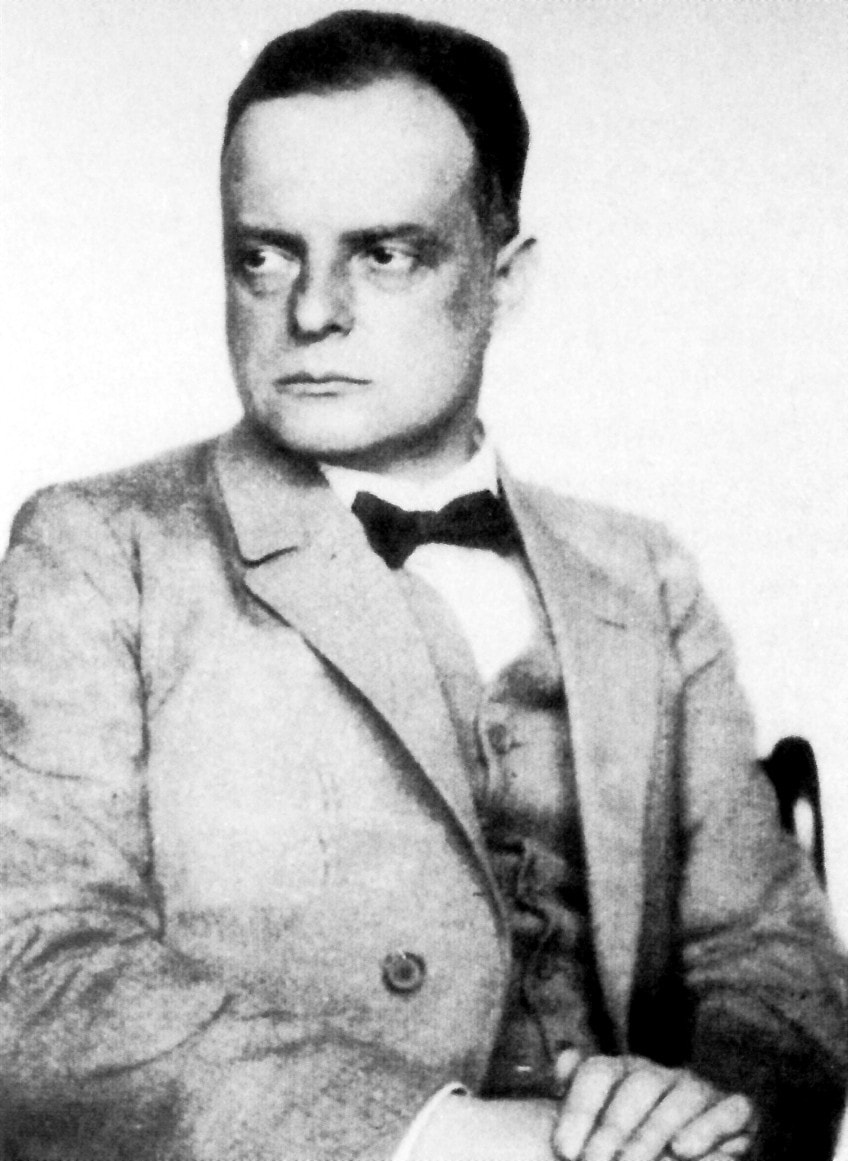
Senecio (1922) by Paul Klee
| Date Completed | 1922 |
| Dimensions (cm) | 40.5 x 38 |
| Medium | Oil on canvas mounted on panel |
| Where It Is Currently Housed | Kunstmuseum Basel |
Senecio (1922) is an example of Klee’s eclectic painting style. It is a colorful abstract portrait done in oil combining geometric shapes to form the face of an old man (Senecio means old man in Latin). Colors are used to create shadows and to highlight facial features, such as the use of white and yellow to draw the viewer’s eye to the jaw, cheekbones, and eyebrows.
Squares and rectangular shapes create the neck and cheeks, while triangles form the eyebrows. The paint was applied roughly, pointing to the expressionistic style.

Some of Klee’s other famous works include:
- Angelus Novus (1920)
- Three Houses and a Bridge (1922)
- Red Balloon (1922)
- The Goldfish (1925)
- Castle and Sun (1928)
Franz Marc (1880 – 1916)
| Artist | Franz Marc |
| When the Artist Lived | 1880 – 1916 |
| Nationality of the Artist | German |
| Where the Artist Lived | Germany and France |
| Associated Art Movements | Cubism, Impressionism, Post-Impressionism, Realism, Modern Art |
Franz Marc was a German artist who was also a founding member of the important Expressionist group, Der Blaue Reiter. His work is characterized by using lively colors and a more cubist style of painting, as well as animals in his works.
The animals, especially horses, portrayed in his works were symbols used to express emotional messages about nature, humanity, and their fate in a toxic world.

Large Blue Horses (1911) by Franz Marc
| Date Completed | 1911 |
| Dimensions (cm) | 105.7 x 181.2 |
| Medium | Oil on canvas |
| Where It Is Currently Housed | Walker Art Center |
Marc’s oil painting, Large Blue Horses (1911), was shown in 1911 in the first exhibition held by Der Blaue Reiter. The work is painted with mostly contrasting primary colors, blue, yellow, red, and green. The curving form of the horses and the color blue gives a sense of harmony and balance, conflicting with the red hills behind them.
Marc intended this to show the juxtaposition between peaceful spirituality and brutality.
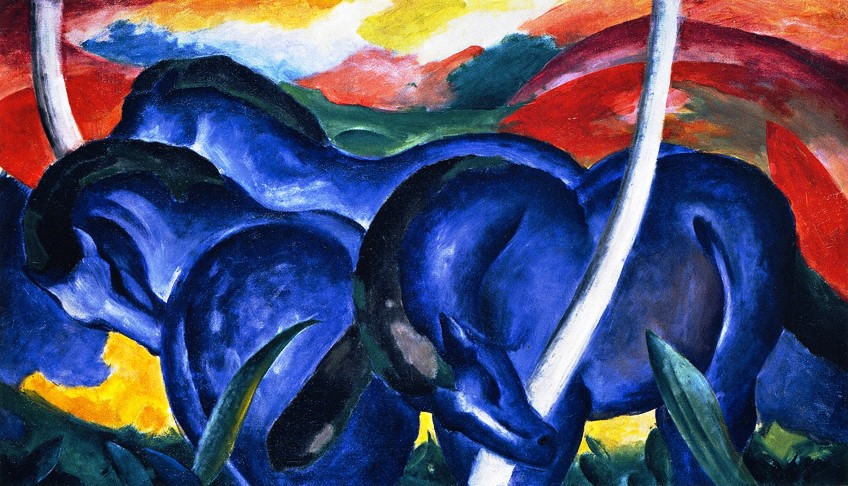
Some of Marc’s other famous works include:
- Two Women on the Hillside (1906)
- The Yellow Cow (1911)
- Tiger (1912)
- Fate of the Animals (1913)
- The Tower of Blue Horses (1913)
Ernst Ludwig Kirchner (1880 – 1938)
| Artist | Ernst Ludwig Kirchner |
| When the Artist Lived | 1880 – 1938 |
| Nationality of the Artist | German |
| Where the Artist Lived | Bavaria and Switzerland |
| Associated Art Movements | Modern Art, Cubism |
Ernst Ludwig Kirchner was a German painter and printmaker and one of the members that founded Die Brücke. Kirchner is considered one of Germany’s most influential Expressionist artists. He was motivated by the same anxiety experienced by the movement regarding their place in a modernizing world, and its fear of losing authenticity and spiritual connection.
He found much inspiration in the modern city and painted sharp, angular forms, using large brushstrokes, and rich blocks of color.
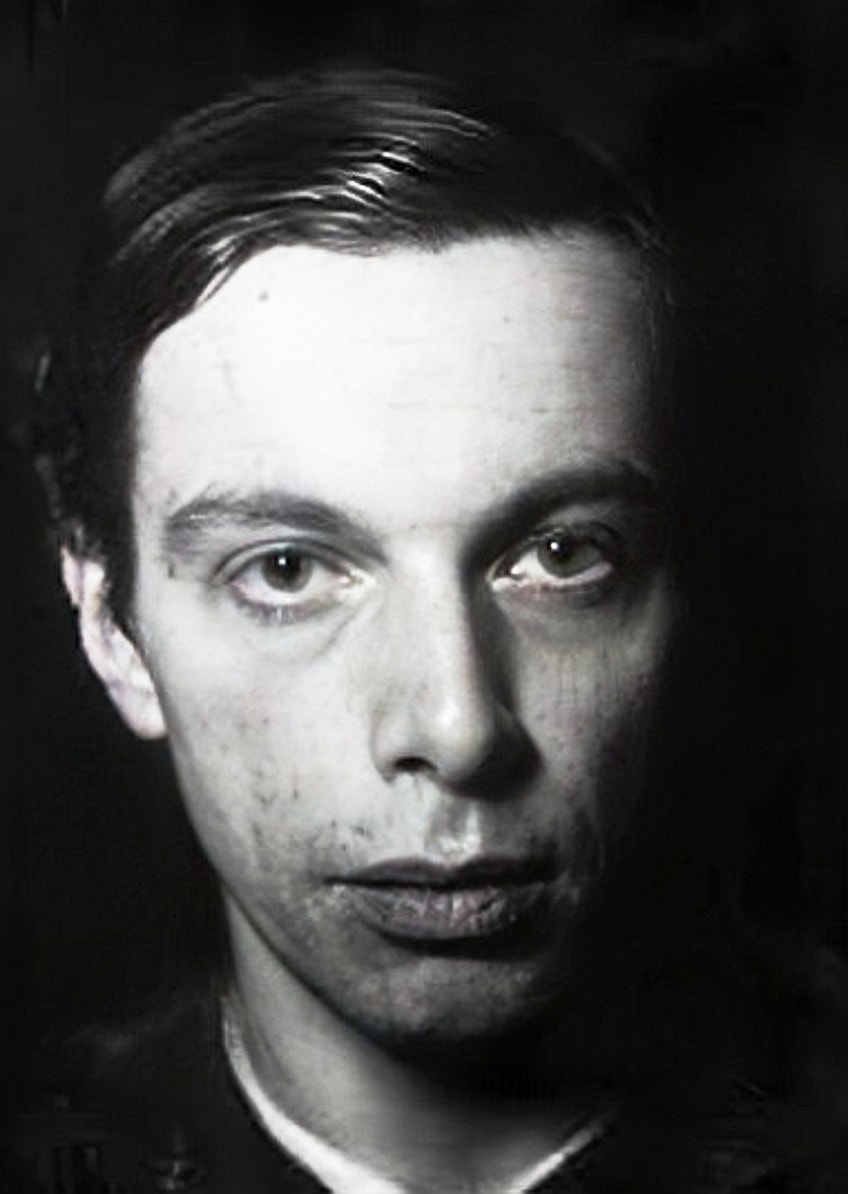
Street, Berlin (1913) by Ernst Ludwig Kirchner
| Date Completed | 1913 |
| Dimensions (cm) | 120.6 x 91.1 |
| Medium | Oil on canvas |
| Where It Is Currently Housed | Museum of Modern Art |
His oil painting, Street, Berlin (1913) is an example of the chaos that Kirchner saw in city life. The painting depicts the city of Berlin, with people rushing about, surrounded by an unsettling mood. This is reflected in his use of jagged shapes, hard brushstrokes, and the contrast of black, purple, and blue colors.
The atmosphere in the painting seems claustrophobic as the figures almost overflow from the picture. The angular faces and tilted perspective promote further disorientation.
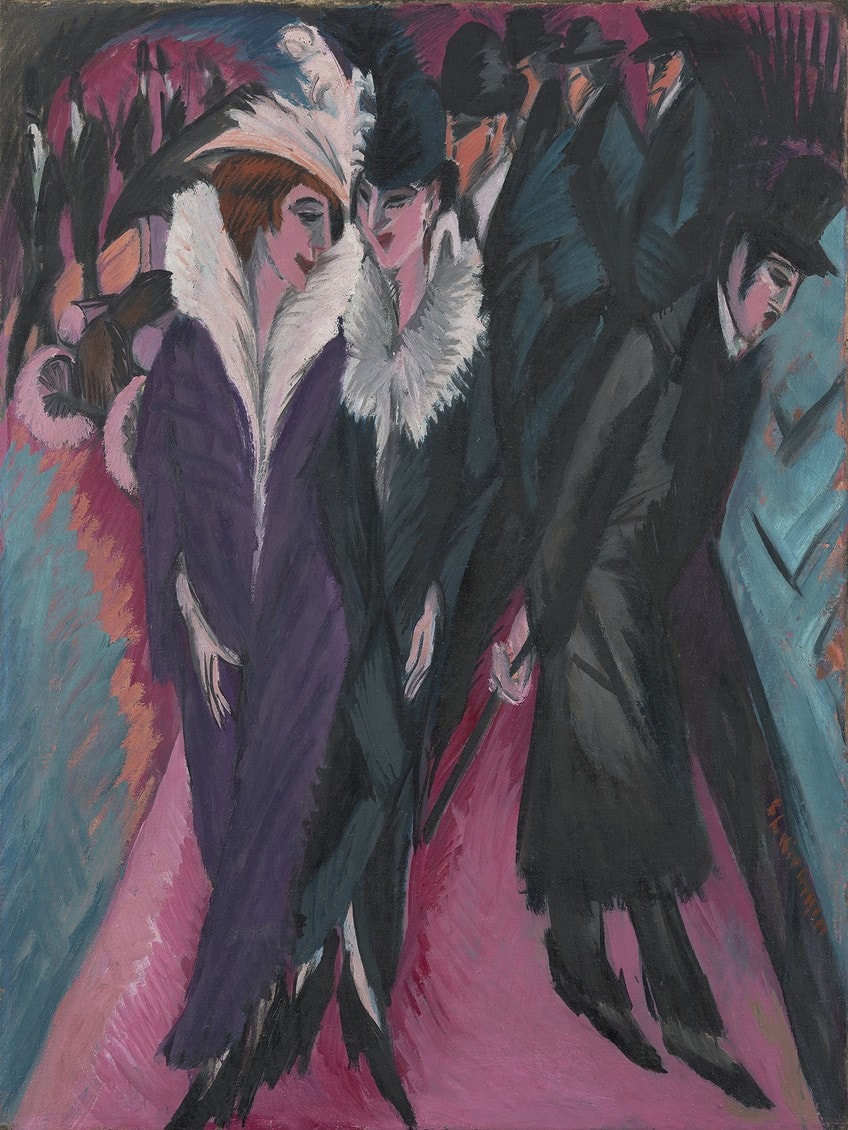
Some of Kirchner’s other famous works include:
- Marcella (1909)
- Berlin Street Scene (1913)
- Five Women on the Street (1913)
- Self-Portrait as a Soldier (1915)
- Bathers (1927)
Erich Heckel (1883 – 1970)
| Artist | Erich Heckel |
| When the Artist Lived | 1883 – 1970 |
| Nationality of the Artist | German |
| Where the Artist Lived | Germany |
| Associated Art Movements | Modernism |
Erich Heckel was a German painter and printmaker and was also a founding member of Die Brücke. Heckel is known for reviving woodcutting in Germany; his woodcuts were striking, with hard lines, angular shapes, and flat colors.
His paintings were not as harsh in style but used softer lines with a variety of color combinations.
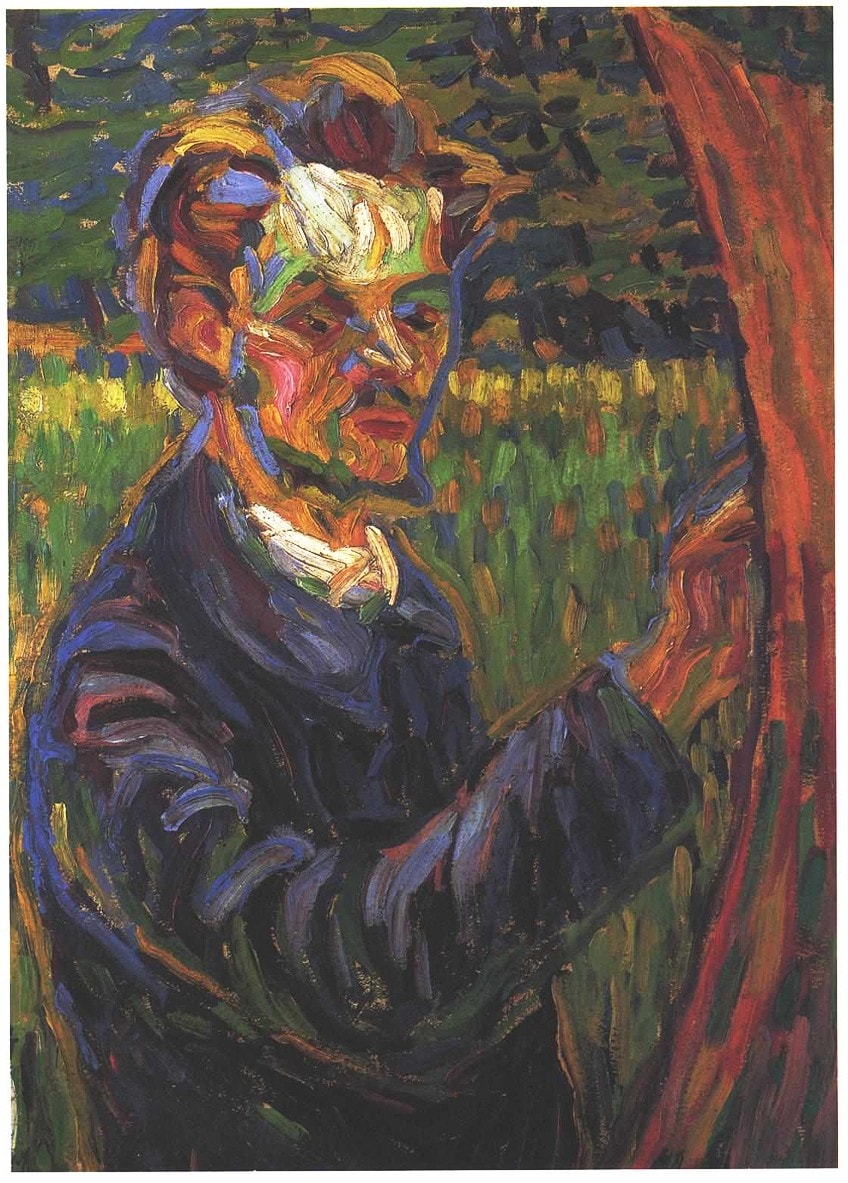
Portrait of a Man (1919) by Erich Heckel
| Date Completed | 1919 |
| Dimensions (cm) | 46.2 x 32.4 |
| Medium | Painted Woodcut |
| Where It Is Currently Housed | The Museum of Modern Art |
Heckel’s work, Portrait of a Man (1919) is a painted woodcut. The figure has strong, defined features, much like his other portraits. The person in the work represents the uncertainty and trauma that took over Germany after the war. His hands clasp his chin while he looks to the left as if he is waiting in anticipation.
The cool colors used alongside the black hard lines also lend a sense of moodiness and anxiety.
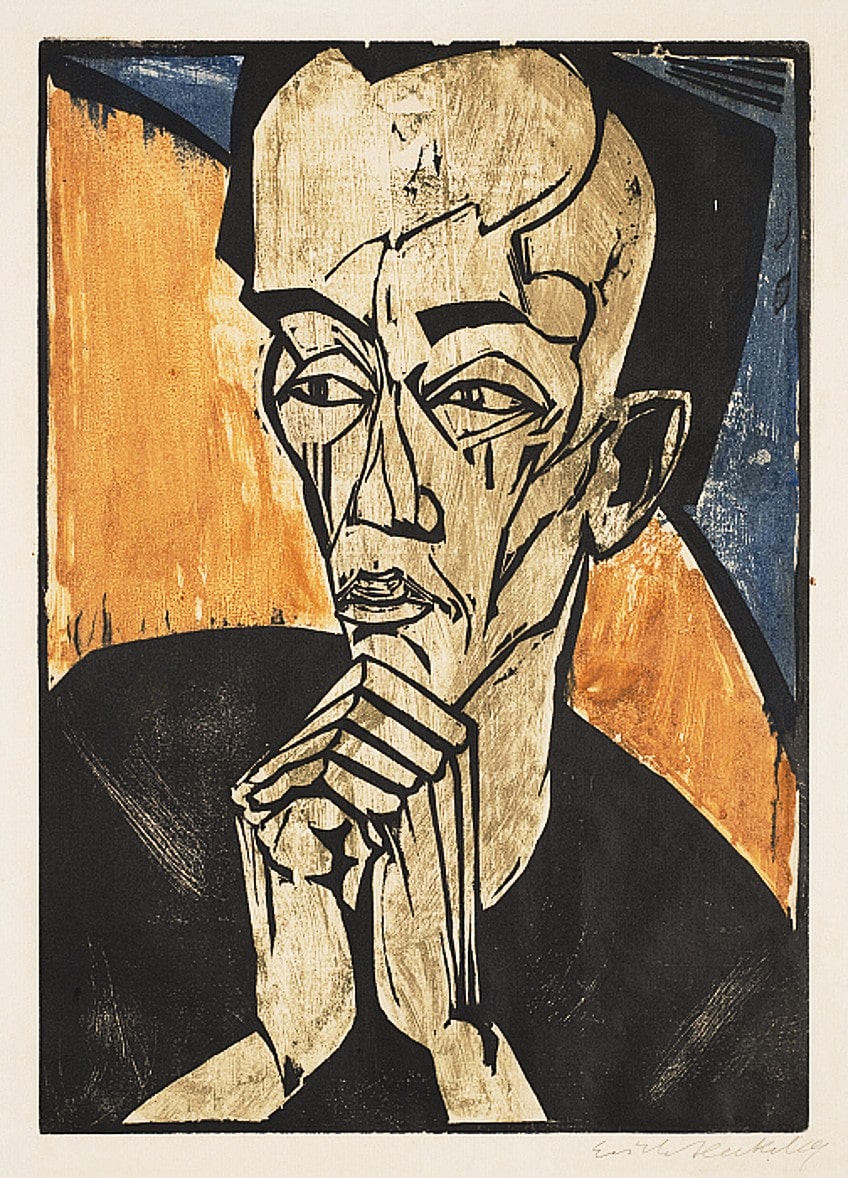
Some of Heckel’s other famous works include:
- House in Dangast (The White House) (1908)
- Fränzi Reclining (1910)
- Bathers (1913)
- Gläserner Tag (Crystalline Day) (1913)
- Tired (1913)
Egon Schiele (1890 – 1918)
| Artist | Egon Schiele |
| When the Artist Lived | 1890 – 1918 |
| Nationality of the Artist | Austrian |
| Where the Artist Lived | Austria |
| Associated Art Movements | Art Nouveau, Modern Art, Impressionism, Symbolism, Modernism |
Egon Schiele was an Austrian figurative painter who had a beneficial impact on the early Modernist period. Gustav Klimt was his mentor, and his creative influence is reflected in Schiele’s graphic artistic style. Known for his continuous drawing technique, Schiele created loose sketches of fluid-like figures.
His work is noted for its raw sexual expression and distorted body shapes, defying conventional beauty standards.
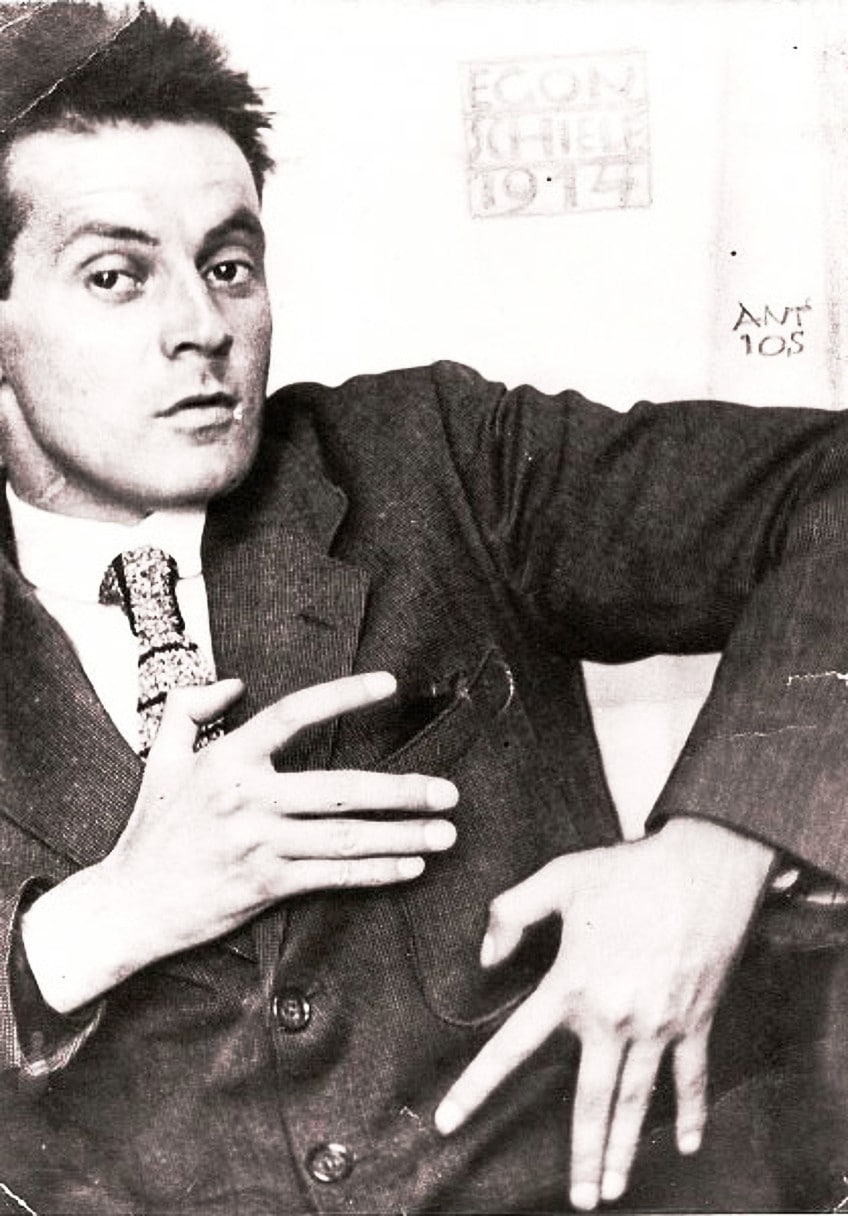
Self-Portrait with Chinese Lantern Plant (1912) by Egon Schiele
| Date Completed | 1912 |
| Dimensions (cm) | 398 x 322 |
| Medium | Oil on canvas |
| Where It Is Currently Housed | Leopold Museum |
Self-Portrait with Chinese Lantern Plant (1912) is an oil painting done on wood and depicts the artist himself sitting at an angle, eyeing the viewer with skepticism. His body is twisted, and his head and facial features are enlarged, emphasizing the psychological element in the piece. The Chinese Lantern plant in the background curves to the right, mirroring the curve of his shoulder on the left.
His face is rendered with much detail and depth of color while his clothing and background are quite flat in comparison.
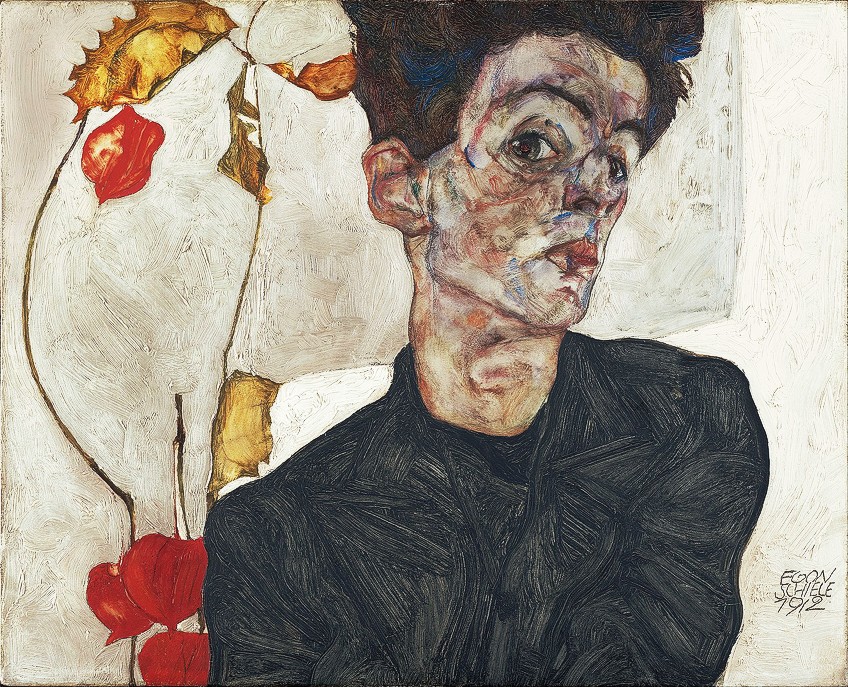
Some of Schiele’s other famous works include:
- Self-Portrait (1910)
- Portrait of Wally (1912)
- Seated Woman (1913)
- The Embrace (1917)
- Seated Woman Legs Drawn Up (Adele Herms) (1917)
Chaïm Soutine (1893 – 1943)
| Artist | Chaïm Soutine |
| When the Artist Lived | 1893 – 1943 |
| Nationality of the Artist | Russian French |
| Where the Artist Lived | Russia, France |
| Associated Art Movements | Modern Art |
Chaïm Soutine was a Russian-born painter who made an important impact on expressionist art while living and working in Paris. His work is characterized by frantic brushwork, thick impasto painting, and how his subjects portrayed his emotional anguish. Soutine had a unique artistic perspective that was influenced by his life experience as an outsider.
He was a Jewish expatriate Russian living in France who did not have many friends, and his loneliness, depression, and temper expressed themselves in his painting.
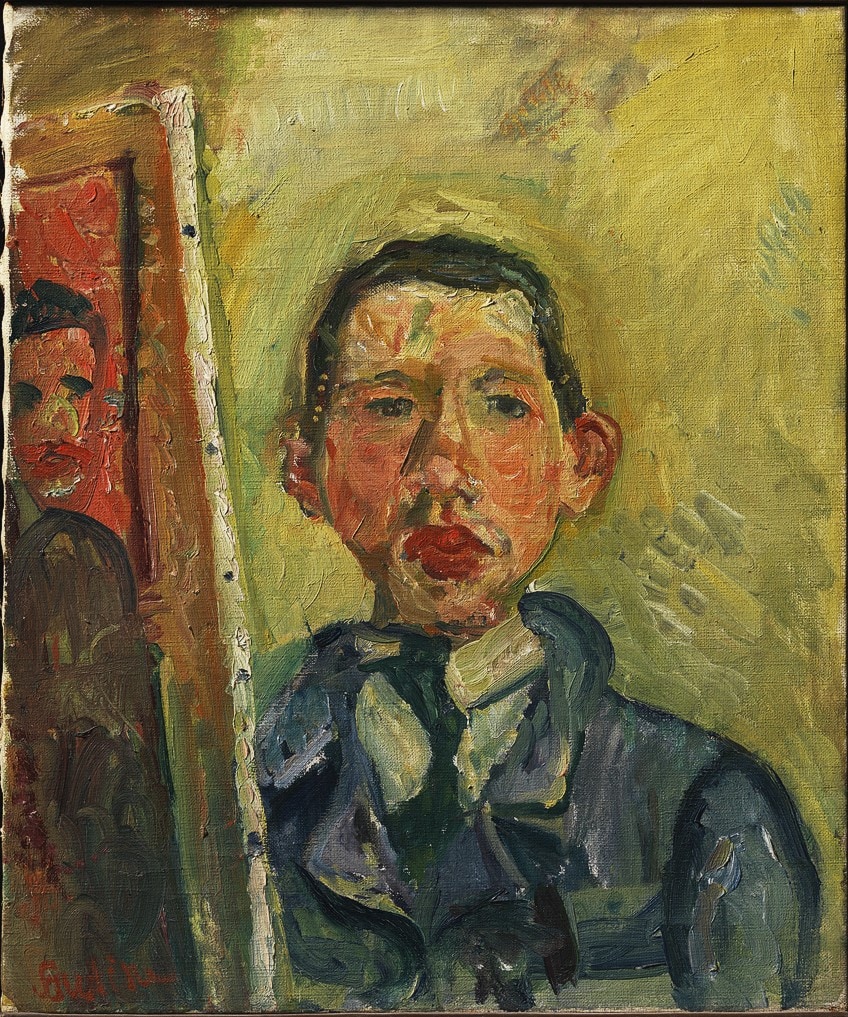
Carcass of Beef (1925) by Chaïm Soutine
| Date Completed | 1925 |
| Dimensions (cm) | 140.3 x 107.6 |
| Medium | Oil on canvas |
| Where It Is Currently Housed | Buffalo AKG Art Museum |
The oil painting, Carcass of Beef (1925) is representative of Soutine’s individualistic subject matter. He grew up poor and was a starving artist for some time until he gained success in his career. He did not eat meat because of his stomach ulcers due to years of nutritional deficiency.
He expressed his strange relationship with meat by painting animal carcasses. In Carcass of Beef, Soutine took inspiration from a painting by Rembrandt entitled, The Ox (1655).

The dead subject is vivid against a dark backdrop of dark hues of blue and grey, creating a somewhat ominous atmosphere. The inside of the carcass is ambiguous with swirling, expressive brushstrokes of red, yellow, and white, but can still be recognized for what it is.
Some of Soutine’s other famous works include:
- Self Portrait (1918)
- The Table (1919)
- Woman in Red (1924)
- View of Cagnes (1924 – 1925)
- Landscape of Cagnes (1925)
Expressionism made a profound impact on the art world and influenced later famous Abstract expressionist artists and Neo-Expressionism. The artists of this significant period expressed in their works the need for change, conveying powerful messages to their viewers even today. There are many masterpieces exploring this style and if you have felt inspired by the 10 artworks above by famous expressionist artists, we encourage you to continue your exploration of the expressionism movement.
Take a look at our Expressionist artists webstory here!
Frequently Asked Questions
What Is Expressionism?
Expressionism is a broad movement that started at the beginning of the 20th century in Northern Europe and spread into various disciplines such as art, architecture, music, literature, and theatre. Expressionistic art is characterized by distortion of form, visible, expressive brushstrokes, and striking color usage. Expressionist painters depicted their emotional or subjective experiences rather than their physical reality
Which Artists Were Involved in the Expressionist Movement?
Artists from various parts of Europe were part of the movement or were associated with it. Some of the most famous expressionism artists were Edvard Munch, Oskar Kokoschka, Ernst Ludwig Kirchner, Egon Schiele, Wassily Kandinsky, Franz Marc, Vincent van Gogh, Käthe Kollwitz, and Max Beckmann.
When Did Expressionism Start and End?
It is important to understand that art movements tend to overlap and influence one another, and therefore it is difficult to apply a defining date. However, Expressionism can be understood to have started in about 1905 and to have lasted until about 1920.
Jaycene-Fay Ravenscroft is a writer, poet, and creative based in South Africa, boasting over 6 years of experience working in a contemporary art gallery. She earned her Bachelor of Arts degree with majors in Art History and Ancient History from the University of South Africa, supplementing her studies with courses in Archaeology and Anthropology. Driven by a passion for learning, Jaycene-Fay finds inspiration in symbology and the interconnectedness of the world. Trained to analyze and critique art, she is enthusiastic about delving into the meanings behind each artwork, exploring its ties to the artist’s cultural, historical, and social context. Writing serves as Jaycene-Fay’s means of researching, sharing knowledge, and creatively expressing herself. For artfilemagazine, Jaycene-Fay writes articles on art history with a focus on historical paintings.
Learn more about Jaycene-Fay Ravenscroft and about us.
Cite this Article
Jaycene Fay, Ravenscroft, “Famous Expressionist Artists – Top Expressionists of the Movement.” artfilemagazine – Your Online Art Source. August 26, 2022. URL: https://artfilemagazine.com/famous-expressionist-artists/
Ravenscroft, J. (2022, 26 August). Famous Expressionist Artists – Top Expressionists of the Movement. artfilemagazine – Your Online Art Source. https://artfilemagazine.com/famous-expressionist-artists/
Ravenscroft, Jaycene Fay. “Famous Expressionist Artists – Top Expressionists of the Movement.” artfilemagazine – Your Online Art Source, August 26, 2022. https://artfilemagazine.com/famous-expressionist-artists/.



